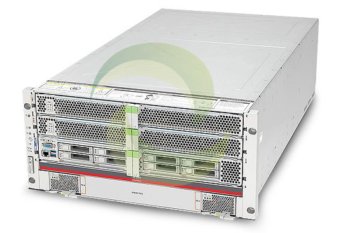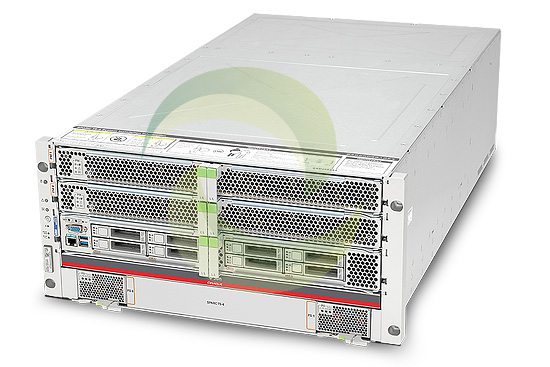Oracle Sun SPARC T5-4 breaks 10000GB Benchmark world record
December 2013
Oracle Sun SPARC T5-4 breaks 100000GB Benchmark world record, delivered world record single server performance of 377,594 QphH@10000GB with price/performance of $4.65/QphH@10000GB USD on the TPC-H @10000GB benchmark. This result shows that the 4-chip SPARC T5-4 server is significantly faster than the 8-chip server results from HP (Intel x86 based).
- The Sun SPARC T5-4 server with four SPARC T5 processors is 2.4 times faster than the HP ProLiant DL980 G7 server with eight x86 processors.
- The Sun SPARC T5-4 server delivered 4.8 times better performance per chip and 3.0 times better performance per core than the HP ProLiant DL980 G7 server.
- The SPARC T5-4 server has 28% better price/performance than the HP ProLiant DL980 G7 server (for the price/QphH metric).
- The SPARC T5-4 server with 2 TB memory is 2.4 times faster than the HP ProLiant DL980 G7 server with 4 TB memory (for the composite metric).
- The SPARC T5-4 server took 9 hours, 37 minutes, 54 seconds for data loading while the HP ProLiant DL980 G7 server took 8.3 times longer.
- The SPARC T5-4 server accomplished the refresh function in around a minute, the HP ProLiant DL980 G7 server took up to 7.1 times longer to do the same function.
This result demonstrates a complete data warehouse solution that shows the performance both of individual and concurrent query processing streams, faster loading, and refresh of the data during business operations. The SPARC T5-4 server delivers superior performance and cost efficiency when compared to the HP result.
Performance Landscape
The table lists the leading TPC-H @10000GB results for non-clustered systems.
| TPC-H @10000GB, Non-Clustered Systems | ||||||
|---|---|---|---|---|---|---|
| System Processor P/C/T – Memory |
Composite (QphH) |
$/perf ($/QphH) |
Power (QppH) |
Throughput (QthH) |
Database | Available |
| SPARC T5-4 3.6 GHz SPARC T5 4/64/512 – 2048 GB |
377,594.3 | $4.65 | 342,714.1 | 416,024.4 | Oracle 11g R2 | 11/25/13 |
| HP ProLiant DL980 G7 2.4 GHz Intel Xeon E7-4870 8/80/160 – 4096 GB |
158,108.3 | $6.49 | 185,473.6 | 134,780.5 | SQL Server 2012 | 04/15/13 |
| P/C/T | = | Processors, Cores, Threads |
| QphH | = | the Composite Metric (bigger is better) |
| $/QphH | = | the Price/Performance metric in USD (smaller is better) |
| QppH | = | the Power Numerical Quantity (bigger is better) |
| QthH | = | the Throughput Numerical Quantity (bigger is better) |
The following table lists data load times and average refresh function times.
| TPC-H @10000GB, Non-Clustered Systems Database Load & Database Refresh |
||||||
|---|---|---|---|---|---|---|
| System Processor |
Data Loading (h:m:s) |
T5 Advan |
RF1 (sec) |
T5 Advan |
RF2 (sec) |
T5 Advan |
| SPARC T5-4 3.6 GHz SPARC T5 |
09:37:54 | 8.3x | 58.8 | 7.1x | 62.1 | 6.4x |
| HP ProLiant DL980 G7 2.4 GHz Intel Xeon E7-4870 |
79:28:23 | 1.0x | 416.4 | 1.0x | 394.9 | 1.0x |
| Data Loading | = | database load time |
| RF1 | = | throughput average first refresh transaction |
| RF2 | = | throughput average second refresh transaction |
| T5 Advan | = | the ratio of time to the SPARC T5-4 server time |
Complete benchmark results found at the TPC benchmark website http://www.tpc.org.
Configuration Summary and Results
Server Under Test:
2 TB memory
2 x internal SAS (2 x 300 GB) disk drives
12 x 16 Gb FC HBA
External Storage:
24 x Sun Server X4-2L servers configured as COMSTAR nodes, each with
4 x Sun Flash Accelerator F80 PCIe Cards, 800 GB each
6 x 4 TB 7.2K RPM 3.5″ SAS disks
1 x 8 Gb dual port HBA
2 x 48 port Brocade 6510 Fibre Channel Switches
Software Configuration:
Audited Results:
| Database Size: | 10000 GB (Scale Factor 10000) |
| TPC-H Composite: | 377,594.3 QphH@10000GB |
| Price/performance: | $4.65/QphH@10000GB USD |
| Available: | 11/25/2013 |
| Total 3 year Cost: | $1,755,709 USD |
| TPC-H Power: | 342,714.1 |
| TPC-H Throughput: | 416,024.4 |
| Database Load Time: | 9:37:54 |
T5-4 Benchmark Description
The TPC-H benchmark is a performance benchmark established by the Transaction Processing Council (TPC) to demonstrate Data Warehousing/Decision Support Systems (DSS). TPC-H measurements are produced for customers to evaluate the performance of various DSS systems. These queries and updates are executed against a standard database under controlled conditions. Performance projections and comparisons between different TPC-H Database sizes (100GB, 300GB, 1000GB, 3000GB, 10000GB, 30000GB and 100000GB) are not allowed by the TPC.
TPC-H is a data warehousing-oriented, non-industry-specific benchmark that consists of a large number of complex queries typical of decision support applications. It also includes some insert and delete activity that is intended to simulate loading and purging data from a warehouse. TPC-H measures the combined performance of a particular database manager on a specific computer system.
The main performance metric reported by TPC-H is called the TPC-H Composite Query-per-Hour Performance Metric (QphH@SF, where SF is the number of GB of raw data, referred to as the scale factor). QphH@SF is intended to summarize the ability of the system to process queries in both single and multiple user modes. The benchmark requires reporting of price/performance, which is the ratio of the total HW/SW cost plus 3 years maintenance to the QphH. A secondary metric is the storage efficiency, which is the ratio of total configured disk space in GB to the scale factor.
Key Points and Best Practices
- COMSTAR (Common Multiprotocol SCSI Target) is the software framework that enables an Oracle Solaris host to serve as a SCSI Target platform. COMSTAR uses a modular approach to break the huge task of handling all the different pieces in a SCSI target subsystem into independent functional modules which are glued together by the SCSI Target Mode Framework (STMF). The modules implementing functionality at SCSI level (disk, tape, medium changer etc.) are not required to know about the underlying transport. And the modules implementing the transport protocol (FC, iSCSI, etc.) are not aware of the SCSI-level functionality of the packets they are transporting. The framework hides the details of allocation providing execution context and cleanup of SCSI commands and associated resources and simplifies the task of writing the SCSI or transport modules.
- The SPARC T5-4 server achieved a peak IO rate of 37 GB/sec from the Oracle database configured with this storage.
- Twelve COMSTAR nodes were mirrored to another twelve COMSTAR nodes on which all of the Oracle database files were placed. IO performance was high and balanced across all the nodes.
- Oracle Solaris 11.1 required very little system tuning.
- Some vendors try to make the point that storage ratios are of customer concern. However, storage ratio size has more to do with disk layout and the increasing capacities of disks – so this is not an important metric when comparing systems.
- The SPARC T5-4 server and Oracle Solaris efficiently managed the system load of nearly two thousand Oracle Database parallel processes.
Error: Contact form not found. |






